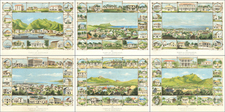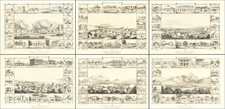Search
Paul Emmert was a Swiss-born moving-picture panorama and scenic painter and lithographer.
By 1845, Emmert had migrated to New York, whereby 1845 he had established himself as a painter in the Bowery.
Emmert in California
In 1849, Emmert sailed to California, where he created the artwork for Emmert & Penfield's Original Panorama of the Gold Mines, the first moving panorama of the Gold Regions of California, which debuted at Gothic Hall in Brooklyn in March, 1850. The first reel traced the route from California to the Isthmus of Panama. The second showed the route from Acapulco to Colima, Mexico. The third reel shows the Entrance to San Francisco through the Golden Gate, the City of San Francisco, Happy Valley, Benicia, the Sacramento River and city. The final reel covered Sutter's Fort, Mormon Island, Mississippi City, Hang Town, Culloma, or Sutter's Mlll, Spanish Bar, Big Bar, Volcanic Bar, Rector's Bar, and more. After a year in New York, the panorama was exhibited in St. Louis in 1851.
After returning to San Francisco in September 1850, Emmert created a new panorama, which debuted in Sacramento at the Pacific Theater in April 1852, which would tour a number of other cities in California. Said to be nearly a mile in length, Emmert 's moving canvas featured representative scenic views and images of the mining districts, as well as a dramatic depiction of the city of Sacramento inundated by the muddy waters of one of the terrible floods that periodically swept the Central Valley.
Emmert in Honolulu
In February 1853, Emmert sailed for Honolulu. He immediately set out to compile a series of sketches, which would become his famed series of six lithographs of Honolulu, which would be published in San Francisco by Britton & Rey in 1854. The numbered set of views consisted of five lithographs entitled View of Honolulu from the Catholic Church and a Panoramic View of the City of Honolulu, Oahu. George Henry Burgess was responsible for much of the lithography in San Francisco, although his name appears on only one of the views.
In November 1853, Emmert published notice, along with Joe T. Downey, of his purchase of a theater business called "Foley's Varieties". Shortly thereafter the business must have gone very badly sideways; the Polynesian records that, in March of 1854, the Supreme Court of Hawaii had ruled against Downey and Emmert and found that they owed Asher B. Bates over six thousand dollars and that their assets were to be liquidated to satisfy the ruling. In May 1854, Emmert published his intention to leave Hawaii in the Polynesian.
In San Francisco, Emmert quickly set about having his drawings turned into views by Britton and Rey, and within months he was headed back to Hawaii.
Upon returning to Honolulu, Emmert set out to sell his views; The Honolulu Friend noted that the set of six lithographs comprised a panorama two feet wide and twelve feel long and took Emmert and two assistants three months to complete at a cost of over $4,000. The views were offered for sale at $3.00 each or a set of six for $15.00, and Emmert opened a lithography and wood engraving studio over Vincent Grenier's store on Nuuanu Street.
Emmert was involved in several other noteworthy projects, including designing the decorations for King Kamehameha IV's wedding in 1856. He made a trip to California as an artist for C.A. Shelton in 1858, before moving to the Kona Coast of the Big Island in 1859 to establish sugar cane plantation. He operated the plantation until 1864, before returning to Honolulu, where he took on assignments for the famous early photographer, Henry M. Chase.


